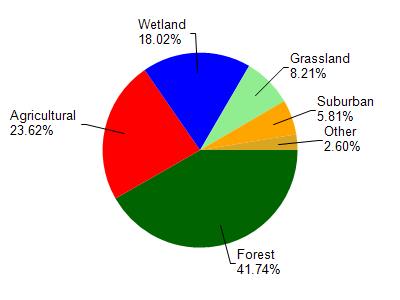Portage
No
No
No
Fish and Aquatic Life
Overview
Glisezinski is a very soft water bog lake located seven miles north of Polonia. The bottom consists of sand and muck. A floating bog and tamarack swamp is present on the north shore. There are no inlets or outlets. Frequent winterkills limit the major fishery to black bullheads. Largemouth bass and bluegills were stocked after a 1968 winterkill. Attempts have been made to control dense aquatic vegetation with only partial success. Floating bog islands, partially submerged, move about the lake and become a problem when the wind forces them to shore. The lake is rapidly being overdeveloped by a Milwaukee based realty firm. Twenty-four cabins are present, and the remainder of the available shoreline is platted. A conflict has arisen between Property owners and large speed boat operators. Many property owners want to pass a speed control ordinance limiting boaters to low speeds. Most wildlife use of the lake is gone due to overdevelopment, however, numerous black terns were observed near the bog.
Source: 1972, Surface Water Resources of Portage County Glisezinski (Jacqueline) Lake, T25N, R9E, Section 4, Surface Acres- 39.7, S.D.F.-1.57, Maximum Depth-17 ft.
Date 1972
Author Aquatic Biologist
Condition
Wisconsin has over 84,000 miles of streams, 15,000 lakes and milllions of acres of wetlands. Assessing the condition of this vast amount of water is challenging. The state's water monitoring program uses a media-based, cross-program approach to analyze water condition. An updated monitoring strategy (2015-2020) is now available. Compliance with Clean Water Act fishable, swimmable standards are located in the Executive Summary of Water Condition in 2018. See also the 'monitoring and projects' tab.
Reports
Management Goals
Wisconsin's Water Quality Standards provide qualitative and quantitative goals for waters that are protective of Fishable, Swimmable conditions [Learn more]. Waters that do not meet water quality standards are considered impaired and restoration actions are planned and carried out until the water is once again fishable and swimmable
Management goals can include creation or implementation of a Total Maximum Daily Load analysis, a Nine Key Element Plan, or other restoration work, education and outreach and more. If specific recommendations exist for this water, they will be displayed below online.
Monitoring
Monitoring the condition of a river, stream, or lake includes gathering physical, chemical, biological, and habitat data. Comprehensive studies often gather all these parameters in great detail, while lighter assessment events will involve sampling physical, chemical and biological data such as macroinvertebrates. Aquatic macroinvertebrates and fish communities integrate watershed or catchment condition, providing great insight into overall ecosystem health. Chemical and habitat parameters tell researchers more about human induced problems including contaminated runoff, point source dischargers, or habitat issues that foster or limit the potential of aquatic communities to thrive in a given area. Wisconsin's Water Monitoring Strategy was recenty updated.
Grants and Management Projects
Monitoring Projects
| WBIC | Official Waterbody Name | Station ID | Station Name | Earliest Fieldwork Date | Latest Fieldwork Date | View Station | View Data |
|---|
| 987100 | Glisezinski Lake | 10017741 | Glisezinski Lake -- Access | 12/9/2010 | 12/9/2010 | Map | Data |
| 987100 | Glisezinski Lake | 503089 | Glisezinski Lake - Deep Hole | 6/1/1994 | 4/20/2025 | Map | Data |
| 987100 | Glisezinski Lake | 10005137 | Glisezinski Lake | 7/27/1999 | 6/18/2024 | Map | Data |
| 987100 | Glisezinski Lake | 503020 | Jacqueline Lake/Glisezinski Lake - Max Depth | | | Map | Data |
|

Watershed Characteristics
Glisezinski Lake is located in the Plover and Little Plover Rivers watershed which is 202.19 mi². Land use in the watershed is primarily forest (41.70%), agricultural (23.60%) and a mix of wetland (18%) and other uses (16.60%). This watershed has stream miles, lake acres and 22,761.70 wetland acres.
Nonpoint Source Characteristics
This watershed is ranked Medium for runoff impacts on streams, Medium for runoff impacts on lakes and High for runoff impacts on groundwater and therefore has an overall rank of High. This value can be used in ranking the watershed or individual waterbodies for grant funding under state and county programs.However, all waters are affected by diffuse pollutant sources regardless of initial water quality. Applications for specific runoff projects under state or county grant programs may be pursued. For more information, go to surface water program grants.